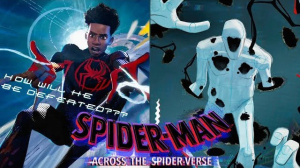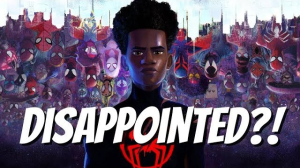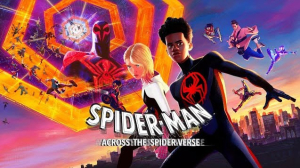


Spider-Man: Across the Spider-Verse
- Feb 15, 2025
Stepping into the theater to watch Spider-Man: Across the Spider-Verse was an experience that felt like entering a realm where imagination meets groundbreaking technology. As I settled into my seat, the anticipation built steadily. The movie offered me the opportunity to glide through multiple dimensions, each brimming with its unique artistry and storytelling style. It was not simply a film for enthusiasts of the web-slinging superhero; it was a layered journey that intertwined vibrant character arcs with breathtaking visuals in a way seldom seen.
Immersed in a Pandemic of Visual Brilliance
From the very beginning, the film captivated my attention with a concoction of colorful aesthetics meticulously arranged to tell its story. The animation was not just about fluid movements or striking details—it was about invoking emotions. I found myself marveling at how the unpredictable brush strokes, vivid color transitions, and inventive animation techniques coalesced better than any traditional piece of cinema. The animation seamlessly transported the narrative from one visually distinct realm to the next, echoing the thematic notion of diversity in experiences and alternate realities. Each frame was a painting, and every visual effect resonated with a passion that encouraged me to appreciate art beyond a mere entertainment spectacle.
Journeying Through a Labyrinth of Dimensions
What set Spider-Man: Across the Spider-Verse apart was its brave adventure into the multiverse. The film intricately weaved together parallel worlds, each characterized by its own intricate storyline and stylistic flair. I was intrigued by the interplay of different worlds that challenged my perception of reality. As the narrative unfolded, I felt a sense of wonder that was both nostalgic and forward-thinking. I encountered settings that were both familiar and radically different from one another, prompting me to consider alternative frameworks of life and heroism. The design choices for each dimension were both daring and emotionally charged, encouraging me to weigh the multiplicity of interpretations that spider-powered heroes might embody in each variant dimension.
An Auditory Feast: Music and Soundscapes
The auditory experience offered an equally compelling dimension to the cinematic narrative. I was particularly drawn into the sound design that stood out as a symphony of modern beats, interspersed with classic motifs that paid homage to earlier depictions of the friendly neighborhood hero. Each scene was underpinned by a meticulously selected musical score that accentuated moments of tension, triumph, and introspection. The soundscapes and rhythmic undercurrents were not mere backdrops; they were integral in narrating the complexities of the character’s journey. I found that the interplay between the visuals and the auditory elements created an immersive atmosphere that lingered in my mind well beyond the closing credits.
Inventive Narrative Techniques and Storytelling Layers
What truly captivated me was the narrative structure that defied linear storytelling. The film expertly harnessed multiple timelines and perspectives—each offering a different lens through which to view the central narrative. I was enchanted by the fluidity of transitions that bridged gaps between diverse story arcs. Character development was imbued with layers of emotion and introspection, prompting me to question the very essence of identity. This innovative approach to storytelling resonated deeply with my own reflections on personal growth and maturity. The narrative’s structural complexity demanded my attention, ensuring that every twist and narrative seam was both a revelation and a homage to the genre’s tradition of bold experimentation.
Characters That Echo Beyond the Screen
My connection to the characters evolved throughout the film. The protagonists were far more than their iconic costumes and abilities; they emerged as symbols of resilience, passion, and the enduring struggle against fate. I marveled at the meticulous crafting of each character's journey, watching them wrestle with internal conflicts that mirrored the external chaos of their battle-scarred universes. The interplay between the characters, their personal dilemmas, and their unified mission made for an emotionally resonant experience. Every dialogue exchange, every moment of vulnerability, reflected the nuanced artistry that the filmmakers invested in making these figures feel as real as the world outside the theater.
Technical Mastery in Animation and Digital Effects
The technical brilliance of Spider-Man: Across the Spider-Verse was glaringly evident in its innovative use of digital effects and animation techniques. I was particularly impressed by the seamless integration of various artistic techniques—not only did this enhance the fluidity of action sequences, but it also paid tribute to the evolution of visual storytelling. The filmmakers extended their craft by blending traditional animation with cutting-edge digital effects, which created a rich tapestry of styles that ultimately contributed to the movie's unique charm. Each sequence felt like a tribute to the relentless pursuit of artistic excellence. The coherence and clarity of even the most frenetic sequences were a testament to the team’s commitment to pushing the envelope of animated filmmaking.
Emotional Undertones and Personal Resonance
Throughout the movie, I felt a constant undercurrent of emotional tension. Each moment, every action sequence, was loaded with the weight of the characters' inner struggles and aspirations. The film deftly navigated themes of love, loss, and the inherent responsibility that accompanies immense power. In a series of intimate moments, I found the characters grappling with personal demons and societal expectations, inviting me to reflect on my own confrontations with identity and purpose. The multi-dimensional emotions that coursed through the narrative offered me a rich layer of engagement that was both intellectually stimulating and emotionally satisfying, ensuring that my experience was not merely a passive viewing but an invitation to introspection.
Innovative Integration of Technology and Artistry
The juxtaposition of technology with artistry in Spider-Man: Across the Spider-Verse was nothing short of revolutionary. I was enthralled by how digital innovations were used to push the boundaries of animated storytelling. The film blended crisp, dynamic motion with stylized design elements to produce a tapestry that felt both modern and reminiscent of classic graphic art. Special attention was given to the comic-book-inspired visuals, with panel-like transitions that evoked the essence of the original printed medium. As I observed the fluidity and precision in every cut and effect, I appreciated the brilliance inherent in the team’s ability to make each digital brush-stroke feel like a deliberate act of creative rebellion against conventional norms.
Dynamic Action Sequences with Meticulous Detail
The intricacy of the action sequences left an indelible mark on my memory. I found the choreography of every move, jump, and twist to define a language of movement that transcended mere physical combat. The film did more than display athletic prowess; it encapsulated the essence of what it means to be a hero who battles against both tangible and intangible odds. The tension that permeated through these sequences encouraged me to become fully engrossed in the unfolding drama. Each scene was a symphony of sound, movement, and emotion that demonstrated how superior technical execution can evoke the thrill of narrative conflict in a way that is both visually arresting and emotionally compelling.
Exploration of Identity Through a Web of Multiverses
Among the many layers of Spider-Man: Across the Spider-Verse, the exploration of identity stood out as a particularly resonant theme. I was fascinated by how the film used the multiverse not simply as a narrative device, but as a metaphor for the variability of the self. Characters confronted versions of themselves that were influenced by disparate cultural backgrounds, moral codes, and personal histories. This narrative decision prompted me to ponder the nature of identity in a world that is increasingly diverse and interconnected. It was intriguing to witness the ways in which each universe presented an alternative perspective on what it means to shoulder responsibility, community, and the weight of expectations. The intersections of various realities allowed me to appreciate the shared humanity present in every narrative arc, regardless of the setting.
A Tapestry of Cultural References and Inspirations
Spider-Man: Across the Spider-Verse was also a journey through a landscape rich with cultural references and artistic homages. I noticed subtle nods to classic comic book panels, historic cinematic techniques, and even broader artistic movements that spanned across decades. The film achieved a delicate balance between celebrating its origins and forging a bold new path forward. This dual engagement with the past and the present served as a reminder of the perpetual evolution of storytelling. As someone who values the cultural significance of art fused with popular media, I was delighted to decipher the layers of meaning embedded in these references. Each scene felt like a conversation between generations—a dialogue that spanned the evolution of an established superhero narrative into a symphony of creative expression.
Personal Reflections on a Journey of Empowerment
Throughout my time immersed in Spider-Man: Across the Spider-Verse, I experienced a personal evolution along with its characters. The film prompted me to reflect on the intricate ways in which our personal challenges can serve as catalysts for growth and reinvention. Every high-stakes moment of action and quiet personal encounter resonated with my own experiences of triumphs and trials. I felt an inexplicable kinship with the struggles portrayed on screen; they mirrored the notion that every individual holds the potential to redefine themselves through persistence and self-discovery. The emotions entwined with each visual cue and piece of dialogue not only enhanced the overall cinematic experience but also reinforced my belief in the transformative power of introspection and courage.
Collaborative Energies Between Storytelling and Innovation
The collaboration between writers, animators, and technical experts in Spider-Man: Across the Spider-Verse was palpable in every frame. I observed a concerted effort to blend traditional narrative art forms with state-of-the-art technology—an ambitious undertaking that demanded both creativity and engineering savvy. The synergy among the creative teams ensured that the film was more than a sequence of impressive visual effects; it was a thoughtfully curated experience that challenged conventional cinematic boundaries. As I watched the story unfold in breathtaking clarity, I marveled at how every element, from the smallest micro-expression to the most expansive visual sequence, was crafted with deliberate attention to detail. The result was a piece of art that transcended simple categorization, merging diverse artistic disciplines into a cohesive and impactful narrative.
An Unfolding Epic in the Midst of a Changing Landscape
Spider-Man: Across the Spider-Verse arrived at a time when audience expectations are evolving, and I could feel that the film was attuned to a broader cultural and artistic shift. The movie demonstrated an admirable willingness to experiment with traditional tropes, pushing the boundaries of what audiences might expect from a superhero story. The interplay of cultural narratives, personal dilemmas, and breathtaking visual experimentation allowed me to witness a new chapter in animated storytelling—a chapter that felt both audacious and refreshingly sincere. The layered complexity of the film invited viewers like me to appreciate the multiplicity of voices and visions that converge in the modern cinematic landscape. Every moment reflected an acknowledgment of the vast potential inherent in the medium, a quiet nod to the future of storytelling that is as rich in diversity as it is in emotion.
- Engaging narrative that intertwines multiple dimensions and innovative storytelling techniques
- Stunning visual aesthetics that blend digital animation with comic-book artistry
- Dynamic character development that resonates emotionally on various levels
- Impressive sound design with a contemporary musical score that enhances scene tension
- Seamless integration of traditional art styles with cutting-edge digital effects
- Multi-layered narrative structure that invites viewers to reflect on identity and purpose
- Some narrative transitions may feel convoluted for viewers less familiar with non-linear storytelling
- Occasional complexity in visual effects might make it challenging to follow fast-paced action sequences
- A few character arcs could benefit from a deeper exploration to connect more with the audience